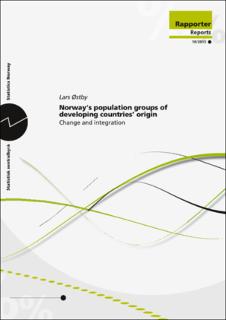| dc.description.abstract | The project, Scandinavia’s population groups of developing countries’ origin:
Change and integration has collected statistics on key aspects of six groups
originating from – Iran, Iraq, Pakistan, Somalia, Turkey and Vietnam – living in
Denmark, Norway and Sweden. The project is carried out in cooperation between
the immigration authorities in Denmark, Statistics Norway and Malmö Institute for
Studies of Migration, Diversity and Welfare (MIM) at Malmö University, and
coordinated by Miroslav Macura the University of Geneva. It was financed by a
grant from the Nordic Council of Ministers, and the participating organisations.
Key aspects of population dynamics are studied for immigrants as well as for their
descendants, along with three facets of integration into the host societies – change
in demographic behavior, participation in the education system, and labor market
integration during the period 1999 to 2008. The study makes extensive use of
national register data, and constitutes one of the first efforts to conduct a
comparative, policy relevant analysis for the same population groups across
different host societies. Comparative analyses will be published by Malmö
University and the University of Geneva later in 2013.
After having presented the national setting, focusing on a broader period, economic
situation and the predominant policies in related areas, population dynamics for the
six population groups are analysed. The immigrant population and in particular our
six groups in focus have been increasing through immigration as well as due to
high birth numbers related to high fertility and young age structure. The Pakistani
group is the largest, immigrants and descendants taken together, but the
immigration from Iraq and Somalia during the decade gave larger numbers of
immigrants from these two countries. The growth for these two groups with a short
history in Norway is much faster than for the other, more mature groups. Duration
of stay is a variable closely related to demographic behavior and integration of
immigrant groups. The marital pattern is characterized by a clear tendency,
although varying between the nationalities and generations, to marry someone of
their own background. The descendants are still too young to make it possible to
conclude how their marital pattern will be.
Education is the basis for a successful integration. The level of participation is
generally much higher for descendants than for immigrants, and varies less between
the population groups for them. Quite naturally, immigrants who have arrived to
Norway recently are not as frequently represented in the educational system as those
who have stayed longer in the country and acquired linguistic and other skills
necessary for successful participation in education. The gender difference in education
is mostly in the same direction as among natives, more women than men are
participating. Often female descendants are considered to be much more active than
men in education, but for many groups the difference in rates between descendant
men and natives are larger than the difference between female descendants and their
native counterparts. The participation rates for descendants in tertiary education have
been strongly increasing during our decade, bringing descendants from Vietnam to far
higher participation rates than the natives in Norway.
As full labour market participation is the aim for many integrational efforts, we
have studied carefully how immigrants and descendants fare in the labour market.
Employment prospects also for immigrants and descendants have been quite
positive. Still, the participation rates for immigrants, and in particular immigrant
women, are much lower than for the natives. One can hardly expect groups coming
from countries with very different labour markets, and different traditions for
female labour market participation, to be able to reach rates characteristic for
countries with among the highest participation rates in the world. Young
immigrants, and descendants, do better than the older immigrants. The gender gap
for some countries (like Pakistan) is a sign that efforts to employ immigrant adult
women have not be quite successful. The level economic inactivity is very high,
especially among immigrants towards the end of their active period in the labour
market, and among women. The difference in activity rates for natives shows that
there is still a way to go before equal activity pattern is obtained. | en_US |

